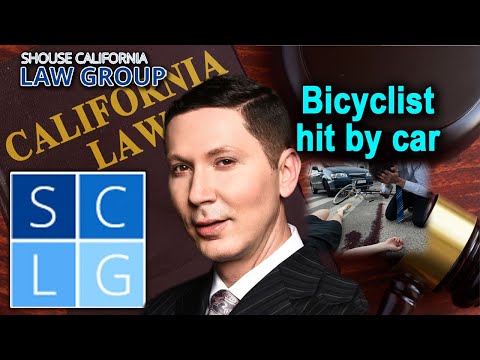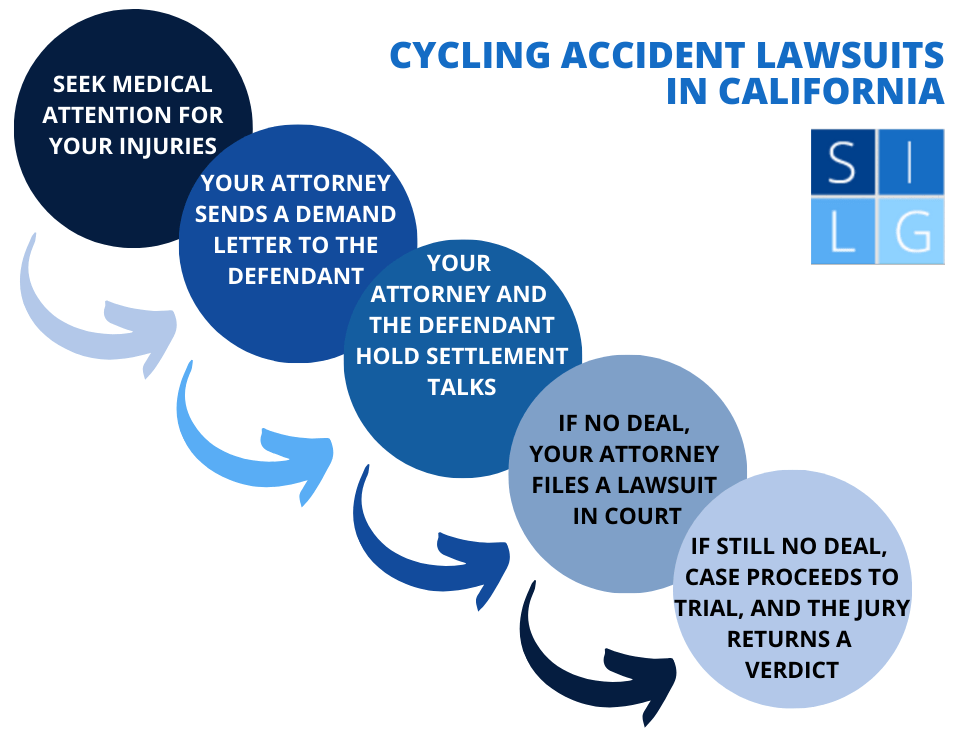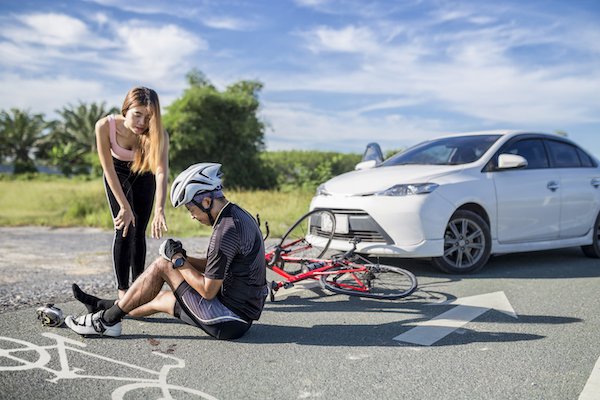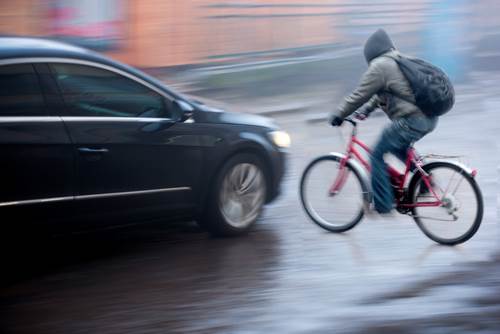

Below, our California bike accident lawyers discuss the following topics:
- 1. Steps to take after an accident
- 2. Money damages
- 3. Suing drivers
- 4. Suing pedestrians
- 5. Suing the city
- 6. Suing the manufacturer or seller
- 7. Wrongful death
- 8. When you are partly to blame
- 9. Bike crashes are common
- 10. Statute of limitations
- Additional resources
If you have further questions after reading this article, we invite you to contact us at Shouse Law Group.
1. Steps to take after an accident
- Seek medical attention. Call 911 if necessary. Your medical records will also serve as evidence.
- Gather information. This includes the vehicle’s license plate number, VIN, make, model, and color; the driver’s name, contact information, and insurance information; and the contact information of any witnesses. Also take photos and videos of the crash scene and your injuries.
- DO NOT ADMIT FAULT. Even if you believe you were to blame, you could be wrong. Perhaps the driver was speeding, drinking, or texting. Anything you say – even a polite “I’m sorry” – could come back to haunt you during a lawsuit.
- DO NOT SAY YOU ARE UNINJURED. It is common for bike crash injuries to take time to manifest, especially with neck, head, or back trauma. If you say, “I’m fine,” that could hinder you from collecting damages later on.
- Contact a California bicycle accident lawyer. Do not try and deal with the driver’s insurance company on your own. The insurance company will probably try to get you to agree to a low-ball offer. Do not settle your case for less than you deserve.
2. Money damages
Following a biking accident in California, you can sue the vehicle driver or other at-fault parties for compensatory damages. This includes money for your:
- Medical bills,
- Counseling,
- Occupation therapy,
- Lost wages,
- Lost earning capacity,
- Loss of consortium (of a spouse or registered domestic partner),
- Disfigurement or loss of limb,
- Scarring, and
- Pain and suffering.
You might also be entitled to punitive damages if the defendant’s conduct was extreme or outrageous. An example is if the driver was trying to run you down. In many cases, punitive damages far exceed compensatory damages.1
3. Suing drivers
If a driver crashed into you, you can sue them for negligence. To win a lawsuit, you would need to prove that:
- The driver owed you a duty of care (since you shared the road);
- The driver breached that duty (such as by running a stop sign or committing other traffic violations);
- The breach caused your injury; and
- Your injury resulted in money damages.2
According to Bicycling Magazine, the five most common bike-car collisions include:
- A driver not seeing a cyclist and making a left turn into the cyclist (this makes up almost half of all bike-car accidents);
- A driver passing a cyclist on the left and turning right into the cyclist’s path (when possible, passing drivers should give cyclists “3 feet for safety” or a full lane when possible);3
- A motorist opening a car door and hitting the cyclist;
- A motorist exiting a driveway or parking lot directly into the path of a bicyclist; and
- Drivers hitting a cyclist from behind.
Note that Vehicle Code 21209 VC prohibits motorists from driving in bike lanes. Drivers who injure cyclists by driving on bike lanes will almost certainly be held liable in court.
4. Suing pedestrians
If a pedestrian caused you to crash, you can sue them for negligence. As discussed in the prior section, you would need to show that:
- The pedestrian owed you a duty of care (since you shared the road);
- The pedestrian breached that duty (such as by suddenly stepping out into the bike lane);
- The breach caused your injury; and
- Your injury resulted in money damages.
Other common causes of pedestrian-cyclist crashes are when the pedestrian:
- loses control of their dog;
- walks while looking down at their phone;;
- listens to their headphones (thereby ignoring traffic noises); or
- runs out in front of a cyclist.

Cyclists usually sustain more serious injuries than drivers from crashes.
5. Suing the city
Under California premises liability law, the city may be liable for your cycling accident by failing to maintain safe streets and bike paths. Common road conditions that lead to bike crashes include:
- Uneven pavement
- Loose gravel
- Lifted asphalt
- Damaged road signs
Just in 2023, Oakland paid $6.5 million to settle a lawsuit with a cyclist who fell due to a crack in the road. The same year, Oakland paid $600,000 to a cyclist who suffered a brain injury after hitting a pothole. Also in 2022, Oakland paid $745,000 to a cyclist who sustained injuries due to a pothole.4
According to the American Society of Civil Engineers (ASCE), there are more than 195,000 miles of public roads in California. Half of those roads are in “poor condition.”5
6. Suing the manufacturer or seller
Some bike accidents are caused by a defective bicycle or bike part. Under California’s “products liability” laws, the company that designed, manufactured, or sold the defective bike product is liable for resulting injuries.
Since product liability cases are based on strict liability, you do not need to prove the company was negligent. Instead, you need to show:
- The defendant designed, manufactured, distributed or sold the bike or bike part;
- The bike or bike part contained the defect when it left the defendant’s possession;
- You used the bike in a reasonably foreseeable manner; and
- You suffered an injury or harm as a result of the defect.
7. Wrongful death
If your family member was killed in a bicycle accident in California, you may be able to file a wrongful death lawsuit against the at-fault parties.6 Family members who can file a wrongful death lawsuit include:
- Surviving spouse;
- Surviving domestic partner;
- Children;
- Grandchildren (if the victim’s children are deceased); or
- Anyone else who would be entitled to the victim’s property under California intestate succession laws.
A wrongful death lawsuit allows you to seek damages for:
- Burial and funeral expenses;
- Financial earnings the victim would have earned as income if they had survived; and
- Compensation for the loss of companionship and support.
Note that the victim’s estate can also bring a “survival” cause of action under California Code of Civil Procedure 377.30. These lawsuits seek damages for the losses suffered by the victim prior to death, such as medical bills and property damage.7

Common bike crash injuries are “road rash,” fractures, and concussions.
8. When you are partly to blame
If you were partly at fault for your bike crash, you can still sue the other at-fault party for damages. Under California’s “comparative fault” law however, the money damages you receive will be reduced by your percentage of fault.
Example: A cyclist sues a driver following a crash that caused the cyclist $10,000 in damages. At trial, the jury determines the driver was 80% negligent for stopping right in front of the cyclist. Meanwhile, the cyclist was 20% negligent because he knew his brakes were not working very well. In this situation, the driver may have to pay the cyclist $8,000 as 80% of the total damages.
9. Bike crashes are common
According to the Centers for Disease Control and Prevention (CDC), every year bike crashes cause more than 1,000 deaths and more than 130,000 injuries.8 California has the sixth highest bicyclist fatalities per capita.9
Even experienced cyclists can be at risk of a bike injury. Factors that place some people at a greater risk of cycling injuries include:
- Age: Those with the highest bicycle death rates include adults aged 50 to 59 years old. However, children and adolescents (5 to 19) have the highest rates of nonfatal bike accidents.
- Sex: Males are 6 times more likely to die and 4 times more likely to be injured on a bike than females.
- Time of day: The majority of fatal bike accidents occur between the hours of 4 p.m. and 8 p.m.
- Urban areas: The majority of fatal bike accidents occur in urban areas and non-intersection areas.
- Helmet use: While a helmet does not prevent bike accidents, it can make a big difference in preventing head injuries or brain trauma.
- Alcohol impairment: More than a third of all fatal bike accidents involved a driver or rider impaired by alcohol.10
10. Statute of limitations
In general, you have two years after your biking accident in California to bring a personal injury claim against the at-fault parties. Though there are situations where the statute of limitations gets “tolled” (paused).
Under California’s discovery rule, the two-year clock does not start running until you discover (or reasonably should have discovered) that you were injured. In most bike accident cases, you realize you were hurt right after your crash. In some cases, though, it may take weeks or longer for your injuries to manifest.
The statute of limitation also tolls if:
- You were a minor (under 18) at the time of the accident;
- The at-fault party is incarcerated or outside of California;
- You are physically incapable of filing a lawsuit; or
- The at-fault party is legally insane.
In cases where the biking crash victim dies, the estate can file a survivorship claim by the later of:
- 6 months after death or
- 2 years after the crash.
In cases where you are suing the government, the statute of limitations to file a “notice of claim” is only six months. If the government denies your claim within the next 45 days, then you have another six months (from the denial date) to file a lawsuit.11
Additional resources
- Pedestrian and Bicycle Information Center – Find general information on bicycles and walking.
- The League of American Bicyclists – A national organization of bicyclists dedicated to creating safer roads.
- California Bicycle Coalition (CBC) – A non-profit that promotes biking as everyday transportation and recreation.
- Caltrans Quick Map – Real-time traffic information.
- California Association of Bicycling Organization (CABO) – An organization dedicated to protecting bicyclists’ interests and to improve bicycling conditions.
Also see our articles on California bicycle laws and Vehicle Code 21200, which imposes on bicyclists many of the same rights and duties as motor vehicle drivers.
Legal References:
- California Civil Code § 3294.
- See, for example, California Civil Jury Instructions (“CACI”) 400. See also California Civil Code section 1714(a) (“Everyone is responsible, not only for the result of his or her willful acts, but also for an injury occasioned to another by his or her want of ordinary care or skill in the management of his or her property or person.”).
- California Vehicle Code 21760.
- Jose Fermoso, Oakland has paid $35M in 10 years to people injured on its dangerous roads, The Oaklandside (December 12, 2023).
- ASCE 2019 Infrastructure Report Card. Infrastructure in California. Key Facts.
- California Code of Civil Procedure 377.60.
- Code of Civil Procedure 377.30.
- Bicycle Safety, CDC.
- Kaia Hubbard, These Are the Most Dangerous States for Cyclists, U.S. News and World Report ().
- Centers for Disease Control and Prevention. Web-based Injury Statistics Query and Reporting System (WISQARS). Atlanta, GA: Centers for Disease Control and Prevention, National Center for Injury Prevention and Control. Available at www.cdc.gov/injury/wisqars. Bicycle Safety, NHTSA.
- California Code of Civil Procedure §335.1. CCP § 341. California Civil Jury Instructions (CACI) 455. See, for example, Brooks v. Mercy Hospital (Court of California, Fifth Appellate District, 2016) ; Alcott Rehab. Hosp. v. Superior Court () ; Shalabi v. City of Fontana () ; Arrow Highway Steel, Inc. v. Dubin () .
